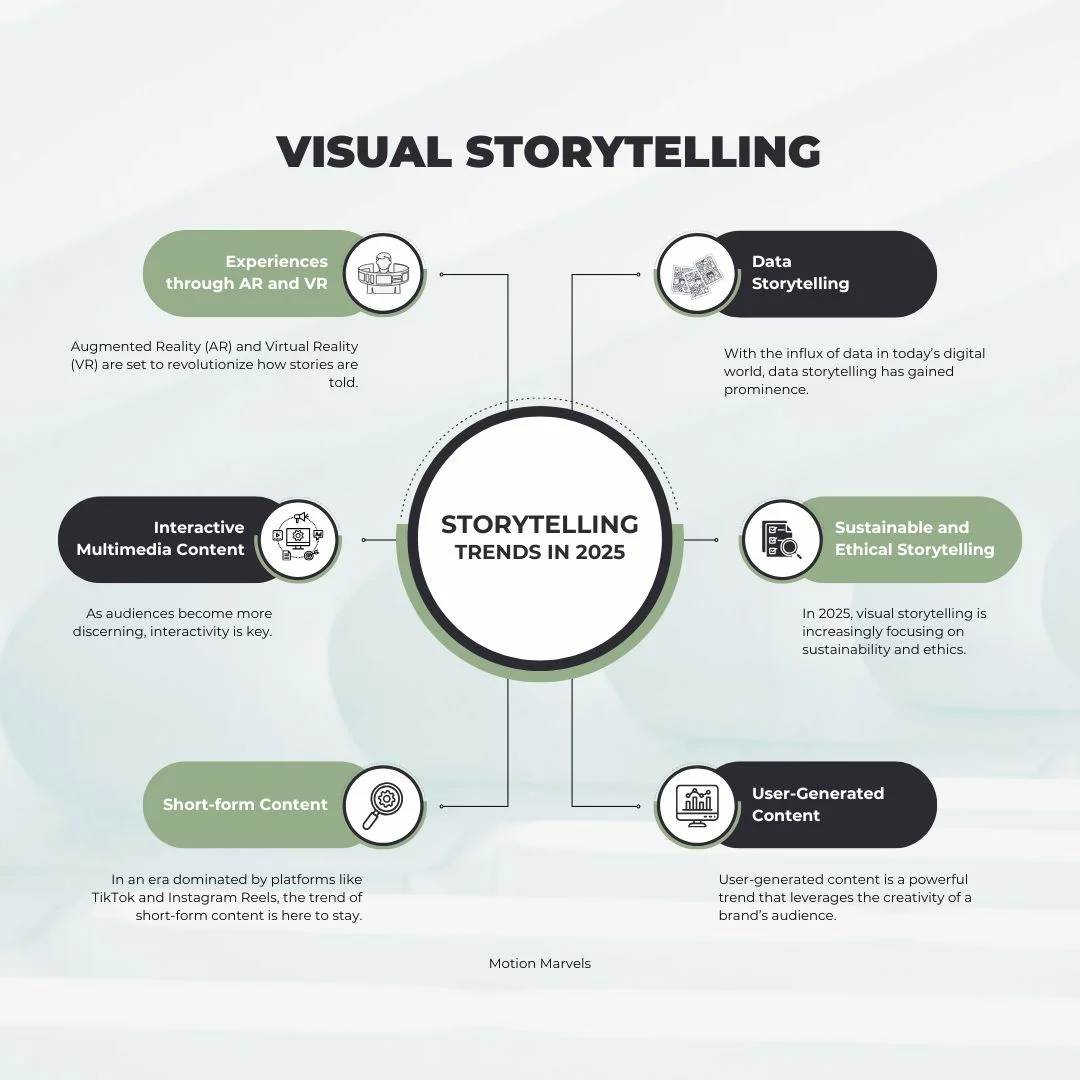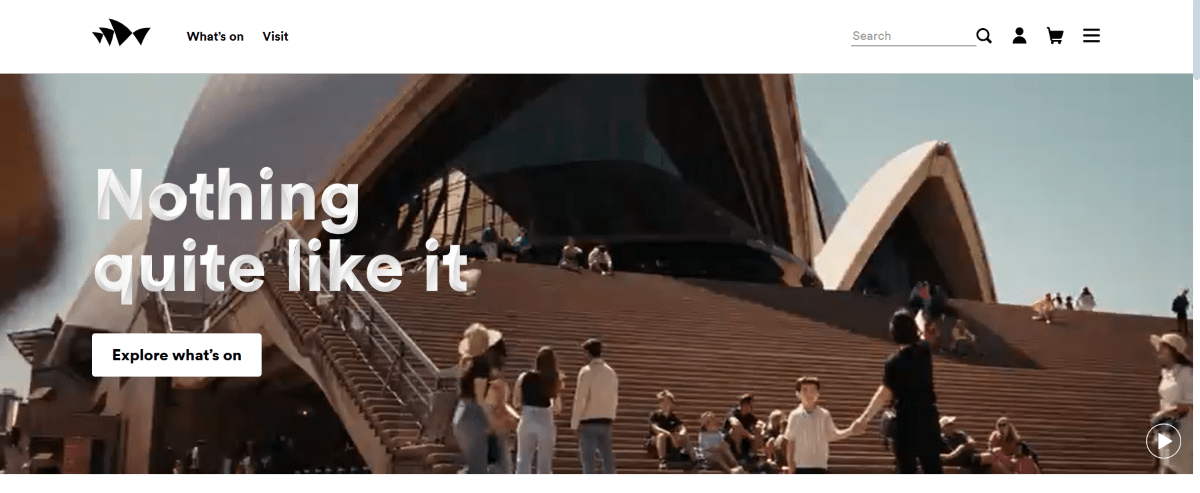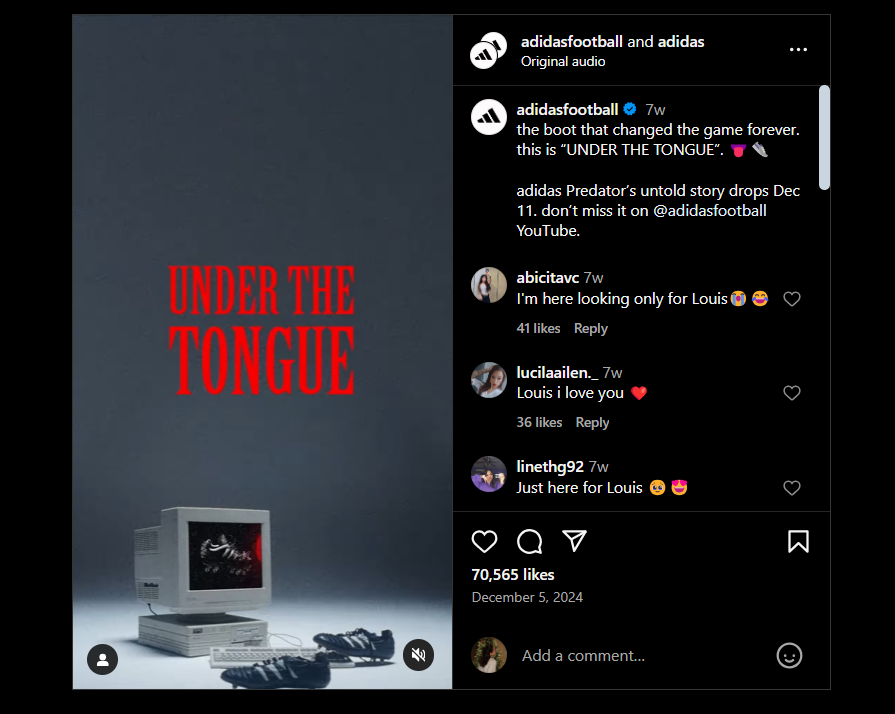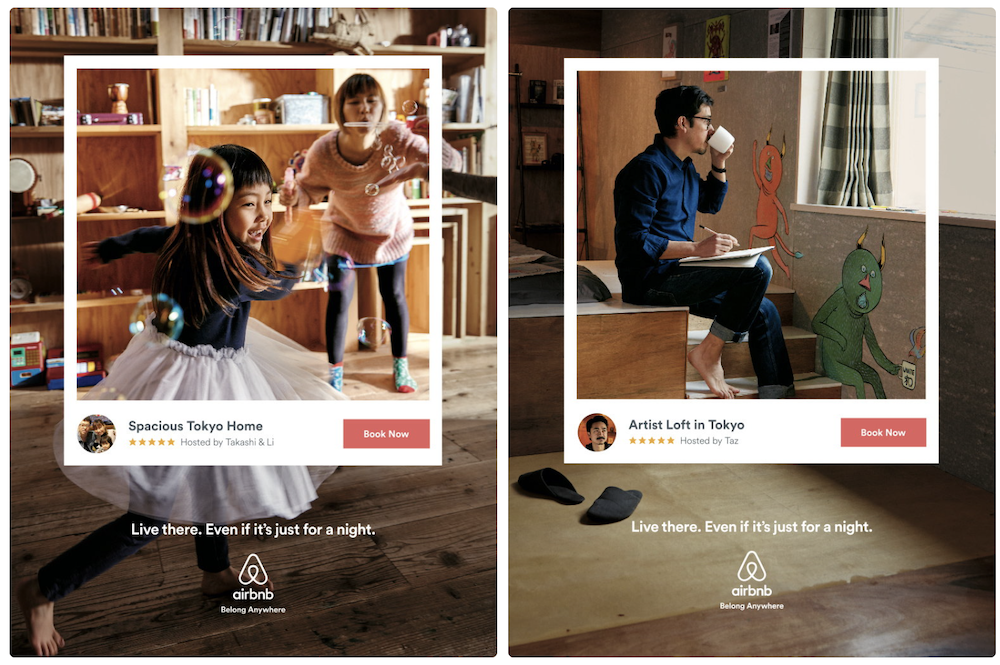How many times have you stopped scrolling to look at a captivating image on your social media feed?
This morning?
Yesterday?
Pretty much every day? 🙂
Unique visuals catch our eye not just because they look good but because the stories they tell speak directly to our emotions.
That’s how visual storytelling has become integral to every successful digital marketing strategy.
What is Visual Storytelling?
Unlike plain text or static ads, visual storytelling brings narratives to life and creates an emotional connection to resonate with audiences on a deeper level. As a rule, visual storytelling has very specific objectives with a clear end goal, whether remembering, sharing, or acting upon.
Effective digital marketing strategies use visual storytelling elements to activate a potential customer’s visual narrative memory. When people see an image or video, their imagination takes over and starts filling in the details, kind of similar to reading a book. Instead of telling them what to think or feel, you allow them to interpret the story in their own way.

Visual Storytelling’s Importance and Impact on Marketing
Visual elements are the glue that helps businesses attract and hold customers’ attention. Conveying complex ideas is much easier through visualization and animation than in text form.
- It simplifies complex ideas: Infographics, animations, or diagrams turn dense data into digestible insights. For example, a marketing agency showcasing ROI growth through a clean, visual case study will likely resonate far better than a wall of text.
- It evokes emotion and builds trust: Humans process images emotionally, not just logically. A powerful visual story can inspire joy, trust, or even nostalgia, influencing buying decisions.
- It boosts brand recall: According to research, people retain 65% of information when paired with visuals, compared to just 10% when presented with text alone. It’s called “The Picture Superiority Effect.”
What are the Key Elements of Visual Storytelling?
Besides a faster attention-grabbing and engaging nature, the use of visual storytelling in digital marketing requires crafting visual narratives that resonate with your audience. That’s why digital marketers should always consider four key elements:
- Color
- Composition
- Content
- Consistency

Setting the Mood and Evoking Emotions Through Colors
Red sparks urgency, passion, and excitement.
Blue is trust and reliability, but it is also sadness and melancholy.
Every color has its connotations, cultural associations, and psychological effects. Choosing your brand colors can seem like a minor aspect of your marketing strategy, but your color palette can create subconscious associations among consumers.
Example

Moreover, Coca-Cola incorporates its red color into Christmas festive celebrations, creating an even stronger emotional bond with its audience.
Tips for Marketing:
- Choose colors that align with your brand identityand set the right mood. For instance, a purple logo can create a sense of calmness and sophistication, while a green one can evoke freshness and naturalness.
- Leverage color psychology to guide customer behavior. Your website CTA buttons can have orange or yellow accents to create a sense of urgency, while your brand’s social media posts can use blue and green tones for trust-building.
- Stay consistent by choosing 1 or 2 key colors and just a few accent shades. Appearing monotone or using too many colors can create a sense of confusion and chaos.
Guiding the Viewers’ Attention with Composition
The arrangement of elements within a visual ensures people look toward the important message more than other points. Designers practice the classic rule of thirds to create dynamic and purpose-driven compositions.

This suggests dividing an image into thirds vertically and horizontally and positioning the most important elements on one of the intersections or along the lines.
Example
Apple’s product pages are masterclasses in composition. Clean, minimalist designs emphasize the product, supported by sleek typography and balanced layouts.

Tips for Marketing:
- Use visual hierarchy by emphasizing focal points with size, color, or contrast. For example, a bold headline paired with supporting imagery draws viewers to the main message.
- Avoid clutter. Negative space (or white space) is your ally, as it helps focus attention on key visuals and text.
- Choose images and graphics that align with your brand’s message and style. For example, avoid using busy or cluttered visuals if your brand is all about minimalism.
Making the Visuals Meaningful Through Context
Stunning visuals can attract the masses and spark conversations, but they are just as likely to fizzle out without meaning or context. This helps you create a series of images that work together, build engagement, and tell a story.
Example
For instance, Colin Kaepernick, who sacrificed his NFL career to take a stand against racial injustice, became a defining figure for the “Just Do It” campaign. Nike filmed an inspiring film with a core idea evolving around the tagline “Believe in something. Even if it means sacrificing everything.”
This is an example of professional storytelling aimed not only to promote a brand but also to raise broader socio-cultural conversations.
Tips for Marketing:
-
- Align your visuals with the cultural or situational context of your target audience. For instance, using holiday-themed imagery during festive seasons instantly makes campaigns relatable.
- Pair visuals with text to provide clarity. Taglines and captions conveying the core message will only fuel your storytelling.
- Focus on authenticity. Stock images can be fine for some cases, but if you want to leave a lasting and genuine impact, you must create or use visuals that connect with your audience on a personal level.
Building Trust and Recognition with Consistency
All your visual elements, including logos, fonts, and imagery, should work cohesively to reinforce brand recognition. Consistency is how you show people your commitment and values.
Example
Starbucks has a very unique approach to keeping branding consistent through all its digital marketing efforts. Thanks to the iconic green-and-white logo, earthy tones, and minimalistic yet inviting designs, the brand has global recognition in everything they do.

Starbucks’ seasonal campaigns tell stories with unique themes that are true to their brand. A prime example is their holiday campaigns with a series of limited-edition cups designed with festive imagery. The designs are always new but unmistakably “Starbucksian”. They use videos, infographics, and professional photography to engage with their community and stay loyal to their tradition at the same time.
Tips for Marketing:
- Pay attention to tone. If your brand is known for humor, for example, maintain that personality across visuals.
- Develop a style guide for standardized visual storytelling. This will help your team have a single source of truth for every asset they create, whether social media posts, emails, website design, etc. Everything should seem familiar and fit into the overall picture.
Connecting on a Human Level Through Emotions
The 4 C’s of effective storytelling techniques, featuring colors, composition, content, and consistency, are all aimed at one thing: connecting with your audience emotionally.
Everything in your visual storytelling should evoke an emotional response depending on the ultimate goals. Whether joy, nostalgia, or even urgency, visuals that speak and make people feel something are always winning.
- Choose the right colors and elements to match the message.
- Have a story to support the visual and give context to the audience.
- Keep the message simple and clear without overcrowding the visuals.
Visual Storytelling Through Multiple Digital Channels + Examples
Studies show that social media posts with images have over 650% higher engagement rates than text-only content, making visual storytelling a go-to resource for many digital marketers and brands.
To effectively communicate a brand’s message through visual storytelling, it’s important to utilize multiple digital channels and have an integrated strategy for:
- Website development
- Social media marketing
- Email campaigns
- Content marketing
Web Design: The Sydney Opera House
Australia’s Sydney Opera House is a prime example of how a website can tell a brand story. From the moment you visit the homepage, you see a stunning video header showcasing the iconic structure and telling a story of different people visiting it. This evokes a sense of cultural significance and unity as we identify the Opera House as a hub of artistic expression.

What’s so unique about this?
- Immersive Header: The high-quality video draws users in, creating an emotional connection before they even scroll.
- Seamless Navigation: Clean design and well-placed imagery guide visitors effortlessly to explore events, history, and behind-the-scenes stories.
- Brand Identity Reinforcement: Everything on the website aims to convey the brand values and engage audiences within seconds. You can stream, listen, and read about the Opera House’s journey, hero performances, and upcoming events in one platform.
Social Media Marketing: How Does Adidas Do It?
Adidas brilliantly uses Instagram to weave visual stories that connect history with innovation. In one standout post, Adidas showcases its decades-long journey of craftsmanship through a short film telling the story of its iconic Predator and the evolution of footwear.

What’s so unique about this?
- Historic Narrative: By featuring past designs alongside current innovations, Adidas tells a story of progress and heritage. This is a great way to evoke certain emotions, like nostalgia, in their audience.
- Social Proof: The video features interviews with prominent athletes and celebrities who have worn Adidas products, creating a sense of credibility and trust in the brand’s quality.
Such examples demonstrate how brands use social media storytelling to communicate their journey and strengthen loyalty.
Email Campaigns: Airbnb
Airbnb’s email marketing is known for its three pillars: personalization, timing, and storytelling. They constantly track user behavior data and craft highly personalized emails. For instance, if a user views a particular property but doesn’t book, they might receive a follow-up email featuring the exact listing. This approach creates urgency while making users feel seen and understood.

Why does this work?
These emails tap into the user’s intent and provide gentle reminders, boosting engagement and conversion rates.
Another thing about Airbnb’s email campaigns is how they use community-generated content, such as Instagram photos, to highlight the unique moments their platform enables. By showcasing real-life travel stories, Airbnb connects emotionally with its audience.

Story-driven content resonates deeply, engaging even less active users and strengthening their relationship with the brand.
Content Marketing: Land Rover
Land Rover’s 70th anniversary campaign is a masterclass in leveraging visual storytelling to celebrate brand heritage, foster emotional connections, and showcase product reliability. Their short film “The Land of Land Rovers” tells the story of a remote Indian community that depends on vintage Land Rovers for their daily lives.
Authentic storytelling provides global appeal with a local focus. While the story is specific to one community, it also tells about the brand’s identity and core values. This is a great example of how visual storytelling can be embedded into content marketing to create a powerful emotional connection with the audience.
Transform Your Visual Storytelling with Andava Digital
With the average attention span being 8.25 seconds (less than a goldfish’s 9-second attention span), you need to capture your audience’s attention quickly and effectively.
At Andava Digital, we’ve been creating custom strategies for brands across the globe for 15+ years, knowing exactly how to use storytelling for maximum impact.
Ready to create stories your audience won’t just see but feel? Let’s talk and and bring your brand’s story to life!